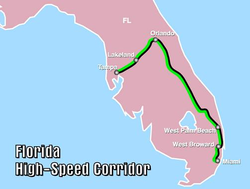Florida High Speed Corridor
| Florida High Speed Corridor | |
|---|---|

Federal Railroad Administration map of the
Florida High Speed Corridor |
|
| Overview | |
| Type | High-Speed Rail (HSR) |
| Status | Proposed |
| Locale |
|
| Termini | Phase 1: Tampa Orlando Phase 2: Miami |
| Stations | Phase 1: 5 Phase 2: TBD |
| Ridership | 2 million yearly (Projection) |
| Website | floridahighspeedrail.org |
| Operation | |
| Opened | Proposed |
| Owner | Florida Rail Enterprise (FDOT) |
| Technical | |
| Line length | 84 mi (135 km) - Tampa-Orlando 240 mi (390 km) - Orlando-Miami 324 mi (521 km) - Total (Proposed) |
| Number of tracks | 2 |
| Track gauge | 4 ft 8 1⁄2 in (1,435 mm) |
| Operating speed | 168 mph (270 km/h) Tampa-Orlando 186 mph (300 km/h) Orlando-Miami |
The Florida High Speed Corridor is a proposed high-speed rail project in the U.S. state of Florida. Initial service would have run between the cities of Tampa and Orlando, with plans to then extend service to South Florida, terminating in Miami. Trains with a top speed of 168 mph (270 km/h) to 186 mph (300 km/h) would run on dedicated rail lines alongside the state's existing highway network.
Construction of the line was slated to begin in 2011, with the initial Tampa-Orlando phase completed by 2014. On February 16, 2011, Florida Governor Rick Scott formally announced that he would be rejecting federal funds to construct the high-speed railway, thereby killing the Florida High Speed Rail project. Governor Scott's reasoning behind cancelling the project was that it would be "far too costly to taxpayers" and that "the risk far outweigh[ed] the benefits".
In the wake of the project's cancellation, a private sector express passenger service running across much of the proposed route has been proposed by All Aboard Florida, a subsidiary of Florida East Coast Industries. This project, Brightline, is due to begin operations in Summer 2017.
After the original federal proposal in the 1960s, U.S. federal and state governments revisited the idea of fast trains from time to time. The Passenger Railroad Rebuilding Act of 1980 led to funding of high-speed corridor studies in 1984. Private-sector consortia intending to build high-speed lines were created in Florida, Ohio, Texas, California, and Nevada. Maglev trains became a new field of interest. They were officially added to the definition of "railroad" in 1988, and were studied repeatedly. Five high-speed corridors were officially endorsed in October 1992 following passage of the Intermodal Surface Transportation Efficiency Act of 1991.TEA-21 and other legislation continued to be passed with mentions of high-speed rail, but lacking funding or real direction.
...
Wikipedia
